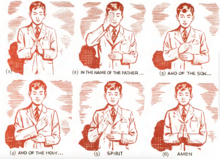
Back Kruisteken Afrikaans Прекръстване Bulgarian Senyal de la creu Catalan Křižování (žehnání) Czech Korsets tegn Danish Kreuzzeichen German Krucosigno Esperanto Señal de la cruz Spanish Aitaren egin Basque Ristinmerkki Finnish

Making the sign of the cross (Latin: signum crucis), or blessing oneself or crossing oneself, is a ritual blessing made by members of some branches of Christianity. This blessing is made by the tracing of an upright cross or Greek cross across the body with the right hand, often accompanied by spoken or mental recitation of the Trinitarian formula: "In the name of the Father, and of the Son, and of the Holy Spirit. Amen."[1]
The use of the sign of the cross traces back to early Christianity, with the third-century treatise Apostolic Tradition directing that it be used during the minor exorcism of baptism, during ablutions before praying at fixed prayer times, and in times of temptation.[2]
The movement is the tracing of the shape of a cross in the air or on one's own body, echoing the traditional shape of the cross of the crucifixion of Jesus. Where this is done with fingers joined, there are two principal forms: one—three fingers (to represent the Trinity),[3] right to left—is exclusively used by the Eastern Orthodox Church, Church of the East, Eastern Lutheran Churches and the Eastern Catholic Churches in the Byzantine, Assyrian and Chaldean traditions; the other—left to right to middle, other than three fingers—sometimes used in the Latin Church of the Catholic Church, Lutheranism, Anglicanism and in Oriental Orthodoxy. The sign of the cross is used in some denominations of Methodism and within some branches of Presbyterianism such as the Church of Scotland and in the PCUSA and some other Reformed Churches. The ritual is rare within other branches of Protestantism.
Many individuals use the expression "cross my heart and hope to die" as an oath, making the sign of the cross, in order to show "truthfulness and sincerity", sworn before God, in both personal and legal situations.[4]
- ^ "The Prayer of the Veil". Encyclopedia Coptica. 2011. pp. 16–17. Retrieved 14 October 2016.
- ^ Hippolytus. "Apostolic Tradition" (PDF). St. John's Episcopal Church. pp. 8, 16, 17. Archived from the original (PDF) on 4 February 2019. Retrieved 5 September 2020.
- ^ Seymour, William Wood (1898). The Cross in Tradition, History, and Art. G.P. Putnam's Sons. p. 419.
- ^ Ayto, John (8 July 2010). Oxford Dictionary of English Idioms. Oxford University Press. p. 79. ISBN 9780199543786.
© MMXXIII Rich X Search. We shall prevail. All rights reserved. Rich X Search